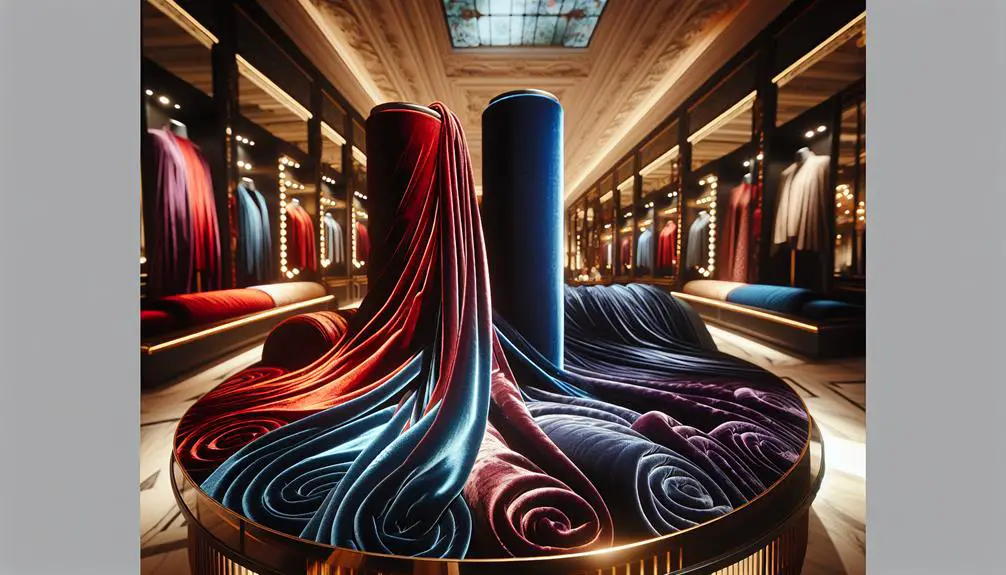I've always been curious about why velvet is perceived as a pricey material. It's true that the cost can vary widely depending on whether it's made from silk or a synthetic fiber. The production process itself is pretty complex, involving special weaving techniques and extra steps like dyeing and brushing. Plus, there's a real sense of luxury and history tied to velvet that other fabrics just don't have. But what really drives the price? Is it simply the production costs, or is there more to the story? Let's unpack what makes velvet so special, and maybe we'll find out if it's truly worth the splurge.
Table of Contents
Key Takeaways
- Velvet pricing varies by fiber type, with silk velvet being the most luxurious and expensive.
- The complex production process and skilled labor required add to velvet's cost.
- Synthetic velvets offer a more affordable option while still providing durability.
- Market trends and global demand can cause fluctuations in velvet prices.
- High-end fashion use and its status as a luxury material often elevate velvet's price.
History of Velvet Fabric
Velvet has a rich history, dating back to ancient civilizations where it was considered a luxury fabric. I've always been fascinated by how materials like these carry stories of the past. When you explore velvet origins, you find that its production started in the Far East. Think of sumptuous robes in China or opulent drapes in Egypt.
Gradually, the allure of velvet spread to the powerful and wealthy across different cultures. By the medieval period, European nobility couldn't get enough of it. This fabric became a symbol of status and power. The cultural significance of velvet is huge; it was all about displaying wealth and sophistication. Kings and queens wore velvet garments during significant events to showcase their might.
In Renaissance Venice, velvet production reached its peak. The city became a key player in velvet manufacturing, which added to its economic strength. This isn't just about a fabric; it's about how a material can influence economies and cultures across centuries. I find it fascinating how something as simple as a type of fabric can hold such importance in the grand narrative of human history.
How Velvet Is Made
Understanding how velvet is made adds another layer to its fascinating story. Let's dive right into the process. It starts with the materials—silk, cotton, or synthetics. I prefer to focus on the weaving techniques, which are truly where the magic happens.
The unique velvet texture comes from a special kind of weaving. Two thicknesses of the material are woven at the same time, connected by tiny loops. A blade then cuts through these loops, creating the soft pile that velvet is famous for. This part of the process is essential; any slip, and the whole texture could be off.
After the cutting, the fabric goes through several finishing steps. It's brushed, treated, and sometimes even dyed. Each step is vital to guarantee that lush, smooth feel that makes velvet stand out.
I find the transformation from plain threads to luxurious velvet fascinating. It's not just about the raw materials but the skilled techniques that create its rich texture. Knowing the effort and precision involved definitely deepens my appreciation for every piece of velvet I come across. It's not just fabric; it's a craft.
Types of Velvet Available
There are several types of velvet, each with unique qualities and uses. Let's explore the different kinds so you can gain a better understanding of what's out there.
First off, there's silk velvet, probably the most luxurious type. It's known for its smooth texture and brilliant sheen. It feels incredibly soft and drapes beautifully, making it perfect for high-end fashion and sumptuous upholstery.
Next up is cotton velvet, which is more matte but still very soft. It's less expensive than silk velvet, which makes it a popular choice for everyday use in both clothing and furnishings.
Then there's synthetic velvet, made from polyester or nylon, offering durability and a lower price point. It's great for those who need a tough material that holds up well in busy settings.
Velvet textures can vary significantly; some are crushed, giving a more casual, textured look, while others are embossed with patterns, adding depth and interest. Velvet colors also range widely, from rich, deep hues to soft pastels, ensuring there's a shade for every taste and occasion.
Whether you're crafting a gown or outfitting a living room, the right type of velvet can make all the difference.
Factors Affecting Velvet Prices
Several factors influence the cost of velvet, including the type of fiber used, production techniques, and the fabric's origin. Let's break it down further:
Firstly, the type of fiber heavily influences the price. Silk velvet, with its luxurious feel, often commands a higher price than synthetic versions like polyester. The production techniques also play a substantial role. Traditional weaving methods are more labor-intensive and therefore pricier compared to modern mechanical methods.
Moreover, where the velvet is made can impact its cost. Fabric produced in regions with higher labor costs will naturally be more expensive. Market trends and global demand also sway the prices. If there's a surge in velvet popularity, prices might spike due to increased demand. Conversely, if it's out of vogue, prices might drop.
Here's a quick look at how these factors stack up:
| Factor | Impact on Price | Example |
|---|---|---|
| Fiber Type | High | Silk vs. Polyester |
| Production Technique | Medium | Handwoven vs. Machine-made |
| Origin | Medium | Italy vs. China |
| Market Trends | Variable | Fashion cycles |
| Global Demand | High | Economic shifts |
Understanding these variables helps explain why velvet's price can vary so widely. It's all about the details!
Velvet in Fashion Industry
As the fashion industry embraces velvet, its unique texture and sheen become key elements in luxury design. I've noticed designers increasingly incorporating it into everything from high-end gowns to trendy streetwear. It's clear that velvet isn't just a fabric; it's a statement.
Velvet trends have evolved dramatically. Last season, we saw a surge in colorful velvet suits that celebrities wore on red carpets worldwide. This season, it's all about mixing velvet with other textures, creating looks that are both eye-catching and tactile. As someone deeply interested in fashion dynamics, I find this material's versatility fascinating.
Celebrity velvet moments also play a huge role in popularizing this fabric. When a star steps out in a velvet dress, it instantly becomes a talking point, influencing trends and consumer choices. I've observed that the impact is immediate—designers pick up on this buzz and incorporate similar styles in their upcoming collections.
For anyone trying to master the art of fashion, understanding velvet's role is essential. It's not just about the material itself but how it's styled and presented. Watching how velvet is continuously reinvented is key to grasping its enduring appeal in the fashion world.
Velvet in Home Decor
Switching gears to home decor, velvet really shines in this arena, too.
I'll explore how velvet furniture adds a touch of elegance, the ins and outs of keeping it clean, and what factors to take into account regarding its durability.
It's amazing how a fabric can transform a space, isn't it?
Velvet Furniture Elegance
Velvet furniture brings a touch of luxury and comfort to any home decor. It's not just about the feel; it's how velvet catches the light, transforming a room with richness that's hard to match. With current color trends, you can find velvet in bold blues and deep greens, adding a pop of color that elevates any space. Its design versatility is unmatched too. Whether it's a modern minimalist look or something more traditional, velvet fits right in.
| Feature | Benefit | Ideal Setting |
|---|---|---|
| Rich Texture | Enhances aesthetic | Living rooms, bedrooms |
| Color Variety | Matches current trends | Any room |
| Soft Surface | Comfortable to use | Lounges, reading nooks |
| Light Reflect | Creates ambiance | Low-light environments |
| Durability | Long-lasting use | High-traffic areas |
Velvet's not just a fabric; it's a statement. Whether you're accessorizing with throw pillows or investing in a full sofa set, it's a game-changer.
Cleaning Velvet Items
Maintaining the elegance of velvet furniture requires knowing how to clean it properly. Here's the deal: velvet isn't your average fabric; it demands special care. First off, I tackle spills immediately. Quick tip: blot, don't rub! Rubbing just pushes the stain deeper. For those stubborn spots, I've learned that specific stain removal techniques are lifesavers. I dab with a clean cloth dipped in a solution of mild soap and water.
For heavier soiling, I don't mess around—I head straight for the dry cleaning solvents. These are designed for fabrics like velvet and can prevent ruining the texture or color. Remember, always test any cleaner on a small, hidden area first. That's how I keep my velvet looking ace!
Velvet Decor Durability
While velvet adds a touch of luxury to any room, it's important to consider its durability when used in home decor. To enhance your understanding and guarantee you make the most out of your velvet pieces, here's what you need to know:
- Choose High-Quality Velvet: Opt for thicker weaves which generally offer better velvet longevity.
- Placement Matters: Avoid placing velvet furniture in direct sunlight to prevent fading and fiber damage.
- Regular Maintenance: Gently vacuum with an upholstery attachment to keep dust and dirt from settling.
- Immediate Care for Spills: Blot spills immediately; liquid can damage velvet if not addressed quickly.
These usage tips will help you maintain the plush look while ensuring it lasts.
Comparing Velvet to Other Fabrics
Let's look at how velvet stacks up against other fabrics, focusing first on the costs of production.
We'll also compare how durable velvet is compared to materials like cotton or silk.
I'm curious to see if it's really worth the price tag!
Velvet Production Costs
When you compare velvet to other fabrics, it often comes with higher production costs. Here's why:
- Raw Materials: Velvet requires high-quality fibers like silk or synthetic materials, which are pricier than the cotton used in simpler fabrics.
- Complex Production: The process to create velvet involves multiple steps, including weaving two thicknesses of material which are then cut apart, adding to labor and time costs.
- Production Regions: Velvet production is often localized in specific regions that may have higher manufacturing costs due to regulations or the environmental impact of sourcing raw materials.
- Specialized Equipment: The machinery needed to produce velvet is specialized and more costly compared to standard textile machines.
Understanding these factors helps explain the premium price of velvet.
Fabric Durability Comparison
Velvet's durability often surprises people, especially when compared to other common fabrics. You mightn't think it, but this plush material holds up pretty well over time. Let's explore why that's the case.
First off, velvet's fabric resilience comes from its unique structure. It's woven with a dense pile of fibers that can actually delve back quite well after being compressed. I've seen wear testing results that support this, showing velvet can withstand a lot of use without losing its luxe look.
Comparatively, lighter fabrics like linen or even some cotton blends don't hold up as well. They often wear thin or fade faster. So, if you're going for longevity in your fabric choices, don't count velvet out. It's tougher than it looks!
Care and Maintenance Costs
Caring for velvet can greatly increase its overall cost. This luxurious fabric needs more attention than your typical cotton or polyester. Let me break down what you're in for if you choose velvet, focusing on professional services and storage solutions.
- Professional Cleaning: Velvet often requires professional cleaning to avoid damage. This isn't a throw-in-the-washer kind of deal. Each visit to the cleaners can add up, especially if you're dealing with upholstered furniture or delicate clothing items.
- Special Storage Solutions: To prevent creases and maintain the fabric's plushness, specific storage solutions are necessary. You can't just fold and stash it anywhere. Think padded hangers for clothes or climate-controlled spaces for furniture.
- Frequent Brushing: Velvet needs regular brushing to keep its texture. You'll need a soft-bristled brush. This isn't a huge cost but consider it a recurring task in your maintenance routine.
- Avoiding Direct Sunlight: Prolonged exposure to sunlight can fade velvet. This means careful placement of velvet items in your home or wardrobe, potentially limiting where you can use or display them.
Each of these points demands time, effort, and, yes, money. But if you're into velvet, these are the hoops you'll jump through to keep it stunning.
Buying Tips for Velvet
When I'm out shopping for velvet, I always check how the fabric feels.
A good quality velvet should be soft and dense.
I also compare prices at different stores to find the best deal.
Plus, I look for care labels to make sure I can keep it looking great without too much hassle.
Identify Quality Velvet
Identifying quality velvet involves checking its weight, fiber content, and weave. You want to feel the plushness and see the sheen that speaks to its quality. Here's what I look out for:
- Weight: Heavier velvet generally means better durability and a richer feel.
- Fiber Content: Silk and cotton velvets often have a more luxurious texture and sheen compared to synthetics.
- Weave Density: Tighter weaves indicate a well-made velvet that'll withstand wear and tear.
- Pile Direction: Run your hand across the velvet. A smooth, even texture that changes shade with direction shows good crafting.
It's all about the sensory experience. Trust your touch and sight to guide you!
Compare Price Points
Let's explore the various price points of velvet to determine where you can find the best value for your money. Velvet affordability really varies.
You've got your synthetic velvets that are generally cheaper, great for a tight budget without sacrificing too much on looks. On the other hand, silk velvet, with its luxurious feel, tends to hit your wallet harder.
Seasonal pricing can also play a big role. Prices may dip around end-of-season sales, so keeping an eye on these can snag you a bargain. It's all about timing and material.
Care and Maintenance Tips
Caring for velvet requires specific strategies to maintain its luxurious texture and sheen. Here's how I keep my velvet looking high-quality:
- Avoid Water: Water can damage velvet's texture. I always use a professional dry cleaner for deep cleaning.
- Brush Gently: To keep the nap lush, I lightly brush my velvet items with a soft clothes brush.
- Proper Storage Solutions: I never fold velvet as it can crush the fibers. Instead, I hang it on padded hangers inside a breathable garment bag.
- Seek Professional Services: For stubborn stains or repairs, I always turn to the pros. It's worth it to preserve the fabric's elegance.
Taking these steps ensures my velvet stays as sumptuous as the day I bought it.
Future of Velvet in Textiles
The future of velvet in textiles looks promising as designers continue to innovate with its use. They're pushing boundaries, especially in velvet recycling and velvet innovation. It's not just about luxury anymore; it's about sustainability too. By finding ways to reuse and revamp velvet waste, they're making high-end fabrics more eco-friendly. This shift is huge because it tackles the big issue of textile waste.
What's really exciting is how tech is changing the game. Imagine velvet that's not only gorgeous but also packed with tech features like temperature regulation or even connectivity. Sounds wild, right? But it's all on the table as possibilities for future velvet uses.
Designers are also experimenting with how velvet can be mixed with other materials to create hybrids that are both functional and stylish. This could open up new markets and applications for the fabric, from sportswear to smart home decor.
I'm convinced that we're only seeing the start of what velvet can do. As technology and eco-awareness continue to grow, velvet's role in fashion and beyond will likely expand. It's a thrilling time to watch, and I can't wait to see where this all goes.
Frequently Asked Questions
Can Velvet Cause Allergic Reactions?
Yes, velvet can cause allergic reactions. It's not common, but if you've got fabric sensitivities, it might be an allergy trigger. Always check the material blend if you're sensitive to certain fabrics.
Is Velvet Suitable for Summer Wear?
Velvet's breathability isn't great for summer wear. While stylish, it's better suited for cooler weather due to its weight and texture. I'd choose lighter fabrics for summer styling to stay comfortable.
Are There Eco-Friendly Velvet Options Available?
Yes, there are eco-friendly velvet options available. I've explored organic velvet options that prioritize sustainability. These fabrics reduce environmental impact, offering a greener choice for those passionate about ethical fashion practices.
How Does Velvet Impact the Environment?
Velvet production impacts the environment through high water usage and emissions. I've learned that these factors contribute greatly to its ecological footprint, urging consumers to explore more sustainable fabric choices.
Can Velvet Be Recycled or Upcycled?
Yes, velvet can be recycled or upcycled, depending on its composition. I've learned proper recycling techniques can extend velvet's longevity, transforming it into new products or rejuvenating its look in creative ways.
- How Does Ring Spun Cotton Affect Garment Fit and Shape Retention? - August 13, 2024
- What Are the Challenges in Producing Ring Spun Cotton? - August 13, 2024
- Is Ring Spun Cotton Suitable for Plus-Size Clothing? - August 13, 2024







